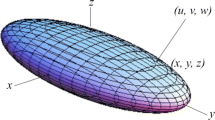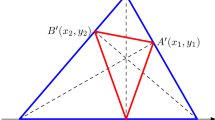Abstract
The Dixon resultant is proposed as an alternative to Gröbner basis or multipolynomial resultant approaches for solving systems of polynomial equations inherent in geodesy. Its smallness in size, high density (ratio on the number of nonzero elements to the number of all elements), speed, and robustness (insensitive to combinatorial sequence and monomial order, e.g., Gröbner basis) makes it extremely attractive compared to its competitors. Using 3D-intersection and conformal C 7 datum transformation problems, we compare its performance to those of the Sturmfels’s resultant and Gröbner basis. For the 3D-intersection problem, Sturmfels’s resultant needed 0.578 s to solve a 6 × 6 resultant matrix whose density was 0.639, the Dixon resultant on the other hand took 0.266 s to solve a 4 × 4 resultant matrix whose density was 0.870. For the conformal C 7 datum transformation problem, the Dixon resultant took 2.25 s to compute a quartic polynomial in scale parameter whereas the computaton of the Gröbner basis fails. Using relative coordinates to compute the quartic polynomial in scale parameter, the Gröbner basis needed 0.484 s, while the Dixon resultant took 0.016 s. This highlights the robustness of the Dixon resultant (i.e., the capability to use both absolute and relative coordinates with any order of variables) as opposed to Gröbner basis, which only worked well with relative coordinates, and was sensitive to the combinatorial sequence and order of variables. Geodetic users uncomfortable with lengthy expressions of Gröbner basis or multipolynomial resultants, and who aspire to optimize on the attractive features of Dixon resultant, may find it useful.
Similar content being viewed by others
References
Awange JL (2002) Gröbner bases, multipolynomial resultants and the Gauss–Jacobi combinatorial algorithm—adjustment of nonlinear GPS/LPS observations. Geodätisches Institut der Universität Stuttgart, Ph.D dissertation
Awange JL and Grafarend EW (2003). Closed form solution of the overdetermined nonlinear 7 parameter datum transformation. Allgemeine Vermessungsnachrichten 110: 130–149
Awange JL and Grafarend EW (2005). Solving algebraic computational problems in geodesy and geoinformatics. Springer, Berlin
Awange JL, Grafarend EW and Fukuda Y (2003). Closed-form solution of the triple three-dimensional intersection problem. Zeitschrift für Geodäsie Geoinformation und Landmanagement 128: 395–402
Bancroft S (1985). An algebraic solution of the GPS equations. IEEE Trans Aerospace Electron Syst AES- 21: 56–59
Bellomo N, Preziosi L and Romano A (2000). Mechanics and dynamical systems with Mathematica. Birkhäuser, Boston
Bernstein DS (2005) Matrix mathematics. Princeton University Press, Princeton, p 142
Buchberger B and Winkler F (1998). Gröbner basis and applications. London mathematical society lecture note series 251. Cambridge University Press, Cambridge
Canny JF and Emiris IZ (2000). A subdivision based algorithm for the sparse resultant. ACM 47(3): 417–451
Cayley A (1865). On the theory of elimination. Camb Dublin Math J III: 210–270
Chtcherba AD and Kapur D (2004). Construction Sylvester-type resultant matrices using the Dixon formulation. J Symb Comput 38: 777–814
Chtcherba AD, Kapur D, Minimair M (2005) Cayley–Dixon construction of resultants of multi-univariate composed polynomials, University of New Mexico, Department of Computer Science, technical report TR-CS-2005-15, April
Dixon AL (1908). The eliminant of three quantics in two independent variables. Proc London Math Soc 6: 468–478
Freeman JA (1994). Simulating neural networks with Mathematica. Addison-Wesley, New York
Grafarend EW and Shan J (1996). Closed-form solution of the nonlinear pseudoranging equations (GPS). Artif Satell 31: 133–147
Haneberg WC (2004). Computational geosciences with mathematics. Springer, Berlin
Helton JW and Merino O (1998). Classical control using H ∞ methods. SIAM, Philadelphia
Kapur D, Saxena T, Yang L (1994) Algebraic and geometric reasoning using Dixon resultants. In: ACM ISSAC 94. Oxford, July, pp 99–107
Kleusberg A (1994). Die direkte Lösung des räumlichen Hyperbelschnitts. Zeitschrift für Vermessungswesen 119: 188–192
Kleusberg A (2003). Analytical GPS navigation solution. In: Grafarend, EW, Krumm, FW and Schwarze, VS (eds) Geodesy—the challenge of the 3rd millennium, pp 93–96. Springer, Berlin
Lichtenegger H (1995). Eine direkte Lösung des räumlichen Bogenschnitts. Österreichische Zeitschrift für Vermessung und Geoinformation 83: 224–226
Macaulay FS (1916). The algebraic theory of modular systems. Camb Tracts Math and Math Phys. Vol. 19. Cambridge University Press, Cambridge
Manocha D (1994). Solving systems of polynomial equations. IEEE Comput Graphics Appl March: 46–55
Nakos G and Williams R (1997). Elimination with the Dixon resultant. Math Educ Res 6: 11–21
Nakos G, Williams R (2002) A fast algorithm implemented in Mathematica provides one-step elimination of a block of unknowns from a system of polynomial equations, Wolfram Research- Mathematica Information Center, electronic publication. http://wolfram.com/infocenter/Articles/2597
Paláncz B, Awange JL, Grafarend EW (2007) Computer algebra solution of the GPS N-points problem, GPS Solutions, GPS Toolbox. Springer, Berlin. doi:10.1007/s10290-007-0066-8
Romeny BMH (2003). Front-end vision and multi-scale image analysis. Kluwer, Dordrecht
Salmon G (1859). Lessons introductory of the modern higher algebra. Hodges and Smith, Dublin
Singer P, Ströbel D, Hördt R, Bahndorf J and Linkwitz K (1993). Direkte Lösung des räumlichen Bogenschnitts. Zeitschrift für Vermessungswesen 124: 295–297
Sturmfels B (1994). Multigraded resultant of Sylvester type. J Algebr 163: 115–127
Sylvester JJ (1853). On a theory of syzygetic relations of two rational integral functions, comprising an application to the theory of Strum’s functions and that of the greatest algebraic common measure. Philos Trans 143: 407–548
Trott M (2005). Mathematica guide book for symbolic computation. Springer, New York
Zaletnyik P, Paláncz B, Awange JL, Grafarend EW (2007) Application of CAS to geodesy: a “live” approach, IUGG XXIV General Assembly, “Earth: our changing planet”, Perugia, Italy, 2–13 July 2007, IAG Symposia, Springer Verlag Berlin, Heidelberg, New York, Vol 133 (in press)
Zavoti J and Jancso T (2006). The solution of the 7-parameter datum transformation problem with- and without the Gröbner basis. Acta Geod Geoph Hung 41(1): 87–100
Author information
Authors and Affiliations
Corresponding author
Rights and permissions
About this article
Cite this article
Paláncz, B., Zaletnyik, P., Awange, J.L. et al. Dixon resultant’s solution of systems of geodetic polynomial equations. J Geod 82, 505–511 (2008). https://doi.org/10.1007/s00190-007-0199-0
Received:
Accepted:
Published:
Issue Date:
DOI: https://doi.org/10.1007/s00190-007-0199-0




